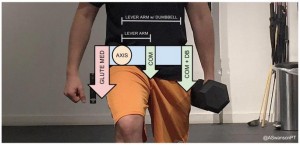There’s a simple physics trick that you can use to increase the demand on the gluteus medius. All you have to do is take advantage of the 1st Class Lever system of the femur and pelvis. You can achieve this by simply loading the opposite side of the hip.
Recent movement research has backed up this classic physics concept. This study showed that during a split squat and walking lunge exercise you can increase glute medius EMG activity by loading the opposite arm with a dumbbell.
By asymmetrically loading the frontal plane, the lever arm to the system’s center of mass (COM) is increased. In other words, loading the opposite side increases the hip drop/trendenlenberg torque on the body. To balance this torque and keep the pelvis level the glute med has to increase its force.
 You don’t have to limit this load application to lunges or split squats. You can also use it during step ups, single leg deadlifts, and loaded walking exercises. You can further challenge the system with different load positions, for example holding a weight in the rack or overhead position.
You don’t have to limit this load application to lunges or split squats. You can also use it during step ups, single leg deadlifts, and loaded walking exercises. You can further challenge the system with different load positions, for example holding a weight in the rack or overhead position.
Altering the load (type, position, weight) can have a profound affect on the body. Having a comprehensive knowledge of physics, biomechanics, and anatomy will allow the practitioner to alter this variable to achieve the desired result.
References & Further Reading
- Petr S, Lehnert M, Mohamed A, Zaki Z, Svoboda Z, Xaverova Z. Does The Dumbbell Carrying Position Change The Muscle Activity During Split Squats And Walking Lunges? Journal of Strength and Conditioning Research 2015. [E pub ahead of print]
Read more in my Basic Biomechanics Series!